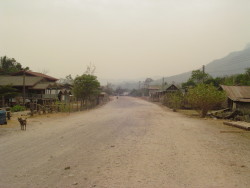
Photo. One of many villages in Laos. © Chris Tharp.
The black paint job was ancient and covered in deep scratches. The hand brake didn’t work at all, and the foot brake felt as if it was attached with a worn out rubber band. Despite its many flaws, the bike held one advantage over the only other motorcycle to be had in town that day: It started.
Finding it
By the time I rolled into Tha Khaek I had been traveling for nearly twenty four hours: A night bus from Bangkok to Vientiane, an overpriced tuk-tuk to the bus station, followed by an eight-hour Lao local that dumped me off in this rotting ex-colonial town.
I had come to Tha Khaek as part of my greater sweep through southern Laos. I had been to the northern part of the country the year before and this time wished to explore the quieter and less-visited southern half. I was seeking isolation, natural beauty, and adventure, and southern Laos seemed just the place to get it. And how would I find it? By motorcycle, of course.
I had gotten the idea for a specific bike trip from a certain guide book, the same guide book that every western tourist clutches like a Gucci handbag, as they wander along the dusty streets of a new town like lost pets. The book mentions a three or four day motorcycle trip that some travelers do out of Tha Khaek, commonly referred to as “The Loop”. It says that the trip takes you through beautiful and remote country, and that it can be performed on a 100cc bike. But can you take one of these down a rocky dirt track and into the hills of southern Laos? Through rural villages? Across rutted tracks and rice paddies? The book recommended the trip, or at least mentions it as a possibility. But had the writer actually done it himself?
Bleary-eyed and hungry enough to eat my own shoes, I staggered off of the local bus and had the rare pleasure of being left alone. No touts swarmed, no children hawked photocopied versions of the guide book, no cyclo drivers chased me down the street shouting “Mister! Mister! Where you go?” A woman and her children, sitting nearby, half-heartedly regarded me, but their attention was better held by the sticky rice and yellowish roast chicken on a stick in front of them. After a few minutes, a tuk-tuk came by, which proceeded to take me to the Tha Khaek Travel Lodge, a guest house that serves the smattering of tourists who pass through, not to be confused with the teddy-bear mascotted cheap motel chain back home, home to endless meth labs and Phish fans.
This Travel Lodge was a compound of sorts, with a courtyard in front, complete with nightly bonfires. So I checked into the shockingly cheap hostel-like dormitory room and proceeded down to the fire, where I chatted with some fellow travelers, downed several bottles of ice-cold beer Lao, and feasted on laap, which is Lao’s national dish of ground beef, onions, and ass-searing chilis.
Photo. Tha Khaek Travel Lodge, the next morning.
After a lager-induced black sleep, I took a cold shower and made my way downstairs for breakfast, which consisted of a noodle soup that had to be ordered twice. This phantom-dish phenomenon plagued me the whole trip, but my patience always endured. It was Laos, after all, where time moves as if it’s encased in a thick gelatin. Laos is also a communist nation that has only recently opened up for visitors, and the people just aren’t used to capitalism, especially in the south, where the tourists are few. Food and drink orders are often met with a panicked look of utter confusion - the proverbial deer in the lights before it meets its end in the grill of a Mack truck. Bills are glacially tallied with looks of semi-despair, as if the people adding them up are working out impossible calculus equations or deciphering cuniform.
The colonial French had a famous saying:
“The Vietnamese plant the rice. The Cambodians watch it grow. The Lao listen to it grow.”
After my two hour noodle breakfast, I asked the guesthouse if there were any motorbikes available; I was informed that they were all rented out. So I slapped on some sunscreen and decided to walk into the town to try my luck.
Tha Khaek is a provincial capital, so there are some large administrative buildings in town, imposing and looking the part of bastions of communist authority. I walked down the main street towards the river, past pharmacies and dark garages, past women grilling chicken and selling boiled eggs, past young men lounging on their motorbikes and daring each other to try out their English on me.
Most of the buildings were low, with faded paint that was cracked or peeling off. The closer I got to the river, the more dilapidated the buildings became, and the more the street became a mixture of paved parts and red dirt patches, as if the town itself was slowly falling into the brown waters of the Mekong. Chickens ran free, and dogs, some with sickeningly-severe mange, laid next to trash mounds and broken concrete on the roadside.
A street in Tha Khaek.
Acting on a tip from the guesthouse, I tracked down SV Rentals, a company that rents out all kinds of equipment for any need in Laos. The company was located in a massive garage near the riverside. Inside were numerous cars – including two brand new shiny Hummers, along with some construction equipment, and two sorry looking 100cc motorbikes. When I asked about the bikes, I was presented with a note, evidently from the guy responsible for renting them to foreigners. It became quickly apparent that this mystery man was the only person in the whole complex who spoke any English at all.
“Dear Sir or Madam. Today I family out of the town the go. Rent motorbike to leave passport with man and taking key. Sorry to problem.”
After choosing the one bike that ran, I handed over my passport and around $30 in Thai baht and was off, cruising down the cracked road of Tha Khaek and joining the locals, most of whom were riding much nicer-looking bikes.
Photo. The bike.
This article continues in Part 2.
Chris Tharp, 26 August 2007
Additional information
Presentation of the author:
Chris Tharp is a former actor, comedian, and playwright from Seattle, Washington. He currently lives in South Korea, where he teaches at Busan Kyungsan College. He spends his spare time writing, fishing, playing music, motorcycling, performing, hiking, drinking, and eating still-moving seafood, though not necessarily in that order. Check out his blog: http://www.livejournal.com/users/tharp42
Information about Laos:
Laos is officially called the Lao People's Democratic Republic. The country is a landlocked communist state in southeast Asia, bordered by Myanmar (Burma) and China to the northwest, Vietnam to the east, Cambodia to the south, and Thailand to the west.
As Lonely Planet describes it on its website (www.LonelyPlanet.com): Snaking rivers, lush jungle, hectic markets and the UNESCO-listed Plain of Jars. Lonely Planet considers Laos as the highlight of Southeast Asia.
Laos traces its history to the Kingdom of Lan Xang or Land of a Million Elephants, which existed from the fourteenth to the eighteenth century. After a period as a French protectorate, it gained independence in 1949. A long civil war ended when the communist Pathet Lao movement came to power in 1975.












